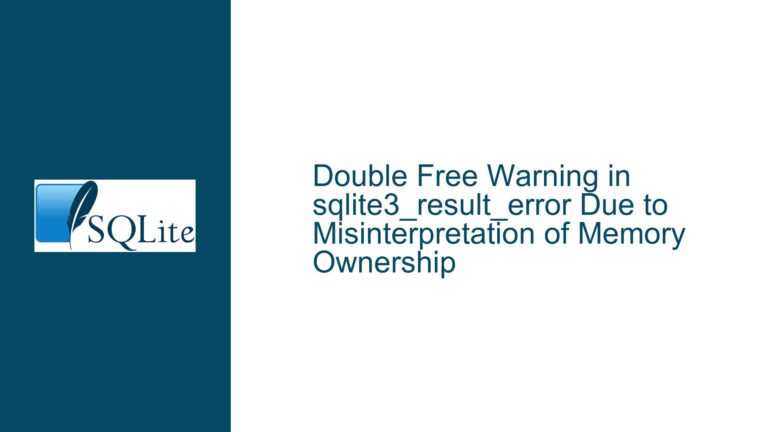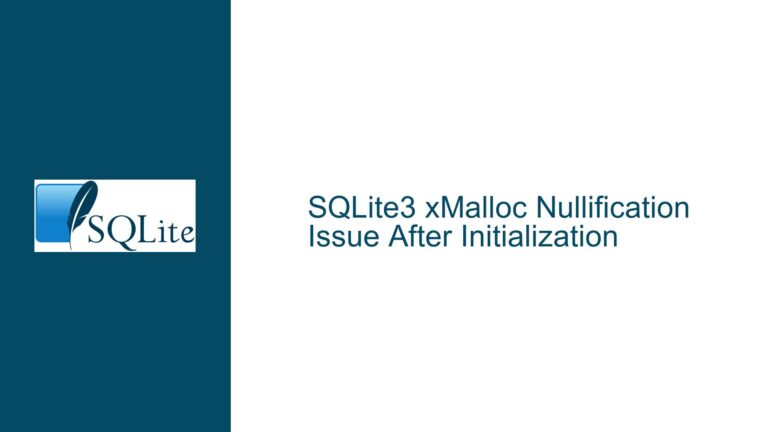SQLite Application ID and Magic Number Registration for File Type Recognition
Issue Overview: Application ID, Magic Numbers, and File Type Recognition in SQLite
SQLite databases are widely used as application file formats due to their simplicity, portability, and self-contained nature. A key feature that enables this usage is the Application ID, a 32-bit integer stored at offset 68 in the SQLite database file header. This ID allows applications to uniquely identify their database files, enabling utilities like the Unix file(1) command to recognize and report the specific application associated with the database, rather than generically labeling it as an "SQLite3 Database."
The magic number system, used by tools like file(1), relies on a database of file signatures (stored in files like /usr/share/misc/magic) to identify file types. SQLite provides a file named magic.txt in its source repository, which lists registered Application IDs and their associated applications. However, this file is not actively maintained by the SQLite team, and its entries are sparse and outdated. This has led to confusion among developers about how to register their Application IDs and ensure their database files are recognized correctly by system utilities.
The core issue revolves around the following points:
- Application ID Registration: Developers need to understand how to choose a unique Application ID and ensure it is recognized by tools like
file(1). - Magic Number Integration: The relationship between SQLite’s
magic.txtand the system-wide magic number database used byfile(1)is unclear, leading to misconceptions about where and how to register Application IDs. - Maintenance and Responsibility: The SQLite team does not actively maintain the
magic.txtfile or handle Application ID registrations, which has caused confusion about the correct process for developers.
This post will explore these issues in detail, providing a comprehensive guide to understanding and resolving them.
Possible Causes: Misconceptions and Gaps in the Application ID Registration Process
The confusion surrounding Application ID registration and magic number integration stems from several key factors:
Misinterpretation of SQLite Documentation:
The SQLite documentation states that developers should set a unique Application ID for their database files and refers to themagic.txtfile for examples of registered IDs. However, it does not explicitly clarify that the SQLite team does not manage the registration process or maintain the system-wide magic number database used by tools likefile(1). This has led developers to believe that submitting a request to the SQLite team is the correct way to register their Application ID.Outdated and Sparse Entries in
magic.txt:
Themagic.txtfile in the SQLite source repository has not been updated since 2014 and contains only a handful of entries. This has created the impression that the registration process is either inactive or not widely used, further complicating developers’ understanding of how to proceed.Lack of Clarity on System-Wide Magic Number Registration:
The Unixfile(1)utility relies on a system-wide magic number database (e.g.,/usr/share/misc/magic) to identify file types. This database is maintained independently of SQLite, and entries must be submitted to the maintainers of thefileutility. Many developers are unaware of this distinction, leading them to direct their requests to the SQLite team instead of the appropriate maintainers.Assumption of Centralized Registration:
Developers often assume that the SQLite team maintains a centralized registry for Application IDs and coordinates with the maintainers offile(1)to update the magic number database. This assumption is incorrect, as the SQLite team does not play a role in the registration process beyond providing themagic.txtfile as a reference.Inconsistent Documentation on Offsets:
The SQLite documentation contains a minor error regarding the offsets foruser_versionandapplication_id. Specifically, it states thatuser_versionis stored at offset 68 andapplication_idat offset 60, when in fact the opposite is true. This error, while minor, can cause confusion for developers working with these values.
Troubleshooting Steps, Solutions & Fixes: A Comprehensive Guide to Application ID Registration and Magic Number Integration
To address the issues outlined above, developers must follow a clear and structured process for registering their Application IDs and ensuring their database files are recognized by system utilities. Below is a detailed guide to achieving this:
1. Choosing a Unique Application ID
The first step is to select a unique 32-bit integer for your Application ID. This integer should not conflict with any existing entries in the magic.txt file or the system-wide magic number database. To ensure uniqueness:
- Consult the
magic.txtfile in the SQLite source repository for a list of registered IDs. - Search the system-wide magic number database (e.g.,
/usr/share/misc/magic) for additional entries. - Use a random or algorithmically generated integer to minimize the risk of conflicts.
2. Setting the Application ID in Your Database
Once you have chosen a unique Application ID, you must set it in your SQLite database file. This can be done using the following SQL command:
PRAGMA application_id = <your_application_id>;
Replace <your_application_id> with the integer value you have chosen. This command updates the database header, storing the Application ID at offset 68.
3. Registering Your Application ID with the file(1) Utility
To ensure that your database files are recognized by the file(1) utility, you must submit your Application ID and associated metadata to the maintainers of the file utility. The process involves the following steps:
- Locate the Magic Number Database: The magic number database is typically stored at
/usr/share/misc/magicon Unix-like systems. You can also find it in the source code of thefileutility on GitHub. - Prepare Your Entry: Create a magic number entry for your Application ID in the format used by the
fileutility. For example:68 belong =0x6a035744 TeXnicard card databaseThis entry specifies that the 32-bit integer at offset 68 should be compared to the value
0x6a035744, and if they match, the file should be identified as a "TeXnicard card database." - Submit Your Entry: Submit your magic number entry to the maintainers of the
fileutility. This can be done by:- Opening an issue or pull request on the
fileutility’s GitHub repository. - Emailing your entry to the maintainers (e.g., Christos Zoulas, the primary maintainer of
file).
- Opening an issue or pull request on the
4. Updating the SQLite magic.txt File (Optional)
While the SQLite team does not actively maintain the magic.txt file, you can still submit your Application ID for inclusion as a reference for other developers. This is not required for file(1) recognition but can be helpful for documentation purposes. To do this:
- Fork the SQLite source repository on GitHub.
- Add your Application ID and associated metadata to the
magic.txtfile. - Submit a pull request to the SQLite team.
5. Addressing Documentation Errors
If you encounter inconsistencies or errors in the SQLite documentation (e.g., the incorrect offsets for user_version and application_id), you can:
- Report the issue to the SQLite team by opening an issue on their GitHub repository.
- Submit a pull request with the corrected documentation.
6. Exploring Alternative File Type Guessing Tools
In addition to the file(1) utility, there are other tools and systems for file type recognition that you may find useful. These include:
- DROID: A tool developed by The National Archives of the UK for identifying file formats.
- PRONOM: A registry of file formats maintained by The National Archives of the UK.
- TrID: A file identifier that uses a database of file signatures to determine file types.
These tools may offer additional features or flexibility compared to file(1), depending on your specific needs.
7. Best Practices for Application ID Usage
To ensure a smooth and effective implementation of Application IDs, follow these best practices:
- Document Your Application ID: Clearly document your Application ID and its usage in your application’s documentation.
- Test File Type Recognition: After registering your Application ID, test the
file(1)utility to ensure it correctly identifies your database files. - Monitor for Conflicts: Periodically check the
magic.txtfile and system-wide magic number database for new entries that may conflict with your Application ID. - Engage with the Community: Participate in forums and mailing lists related to SQLite and file type recognition to stay informed about updates and best practices.
By following these steps and best practices, you can effectively register your Application ID, ensure your database files are recognized by system utilities, and avoid common pitfalls in the process.
This guide provides a comprehensive overview of the issues surrounding Application ID registration and magic number integration in SQLite. By understanding the nuances of these processes and following the outlined steps, developers can confidently implement and maintain their application file formats.






